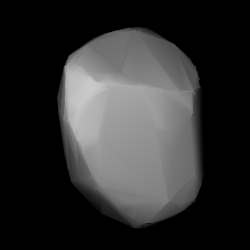 Modelled shape of Gudrun from its lightcurve | |
| Discovery | |
|---|---|
| Discovered by | Max Wolf |
| Discovery site | Heidelberg Obs. |
| Discovery date | 18 March 1892 |
| Designations | |
| (328) Gudrun | |
| Pronunciation | /ˈɡʊdruːn/[1] |
Named after | Gudrun |
| Main belt | |
| Orbital characteristics[2] | |
| Epoch 31 July 2016 (JD 2457600.5) | |
| Uncertainty parameter 0 | |
| Observation arc | 104.41 yr (38135 d) |
| Aphelion | 3.43998 AU (514.614 Gm) |
| Perihelion | 2.78126 AU (416.071 Gm) |
| 3.11062 AU (465.342 Gm) | |
| Eccentricity | 0.10588 |
| 5.49 yr (2003.9 d) | |
| 325.246° | |
| 0° 10m 46.747s / day | |
| Inclination | 16.1164° |
| 352.328° | |
| 103.924° | |
| Physical characteristics | |
| Dimensions | 122.92±5.2 km[2] 122.59 ± 3.72 km[3] |
| Mass | (3.16 ± 0.46) × 1018 kg[3] |
Mean density | 3.27 ± 0.55 g/cm3[3] |
| 10.992 h (0.4580 d) | |
| 0.0425±0.004 | |
| 8.8 | |
328 Gudrun is a main-belt asteroid.
It was discovered by Max Wolf on March 18, 1892, in Heidelberg.
Analysis of the light curve generated from photometric data collected in March 2012 provide a rotation period estimate of 10.992±0.002 h with a brightness variation of 0.32±0.02 in B magnitude.[4]
- ^ "Gudrun". Merriam-Webster.com Dictionary. Merriam-Webster.
- ^ a b "328 Gudrun". JPL Small-Body Database. NASA/Jet Propulsion Laboratory. Retrieved 11 May 2016.
- ^ a b c Cite error: The named reference
Carry2012was invoked but never defined (see the help page). - ^ Cite error: The named reference
Schmidt2012was invoked but never defined (see the help page).